ADVERTISEMENT
Next, sprinkle a light layer of baking soda over the area. You’ll see a little fizz as it reacts with the vinegar—this helps lift mold and grime from the surface and acts as a gentle abrasive.
Step 4: Scrub Gently
Using a sponge or brush, scrub the wall gently in circular motions. This will help lift mold and remove loose paint without damaging the wall beneath.
Step 5: Rinse and Dry
Wipe the area with a clean damp cloth to remove any remaining residue. Then, dry the wall completely using a towel or allow it to air dry with good ventilation.
✨ Optional Finish: Prep for Repainting
If the wall looks clean and dry, and you’re planning to repaint it:
- Sand lightly to smooth any rough patches
- Apply a mold-resistant primer
- Repaint with anti-mold or moisture-resistant paint to prevent future issues
💡 Pro Tips:
- Run a dehumidifier or open a window after cleaning to prevent moisture buildup.
- Always fix leaks or poor ventilation—the root cause of mold—before treating the wall.
- For stubborn mold, repeat the process or try adding hydrogen peroxide (in moderation) for extra cleaning power.
✅ Final Thoughts
This quick trick is not only budget-friendly and chemical-free but also effective in tackling two of the most common wall problems—mold and peeling paint. It’s a great first step before considering costly renovations or repainting. Plus, it leaves your home smelling fresh and feeling clean.
Next time you spot unsightly spots or flakes on your walls, skip the stress. With a few pantry staples and a little elbow grease, you can restore your walls and breathe easier—literally!
